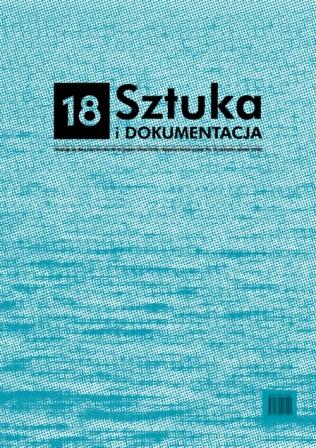NURT DOKUMENTALNY W POLSKIEJ SZTUCE WSPÓŁCZESNEJ
DOCUMENTARY TREND IN POLISH CONTEMPORARY ART
Contributor(s): Ewelina Wejbert-Wąsiewicz (Editor), Emilia Zimnica-Kuzioła (Editor)Subject(s): Cultural history, Sociology of Art
Published by: Akademia Sztuk Pięknych w Gdańsku
Keywords: documentary trend; document; archives; theater; cinema; contemporary art; performativity; verbatim
Summary/Abstract: Documentary art exploits facts, elements of history and authentic events in order to show contemporary problems more clearly, to describe the socio-political and cultural reality and to register the present. It is focused on designing a new world, on social change and on the development of civil society. It is to raise awareness and mobilize to analyze the existing status quo - as engaged and engaging art, it does not confine itself to interpreting reality. Artists - together with viewers of art- pay attention to phenomena that are marginalized or overlooked in the public discourse of symbolic elites.The field of documentary art takes part in the public debate and it destroys stereotypes; it isa transgression, an area of freedom, opposition and contestation, a barometer of social moods. It develops democratic and pluralistic ideas, examines things perfectly obvious with suspicion, aims at deconstruction and reconfiguration of selected elements of culture. The subject of its interest is, among others, homology between the artistic field and the field of power (Pierre Bourdieu) or, asJacques Ranciere puts it, "aesthetics as a form of politics".The thesis proposed by the authors concerns the fact that broadly defined documentation (factualism, biographism, autobiographism, self--analysis, historism, experience, interview, archive, registration and many others) has been deeply affecting contemporary art in its various forms for years. This non-fiction turn is clearly visible in theatre(eg verbatim, documentary theatre), in cinema(eg trend towards authenticity, realism, biography),in literature (eg strong position of reportage) and in performative and visual arts, including women's or feminist art (drawing from life experiences).The section's editors have invited authors of texts representing various disciplines about art to collaborate in order to reflect on the documentary trend in Polish contemporary art.Katarzyna Niziołek in the text “PerformingMemory. Between Document and Participation,”writes about the theatre as a medium of collective memory work. She is interested in the relationship between participatory theatre and collective memory. The author describes selected theatrical projects from the documentary stream, demonstrating how they work through conflicts, historical traumas and, as a result, undermine the dominant frames and narratives. Patrycja Terciak also invokes in her text the practice of contemporary, documentary and engaged theatre. Her text “Between Public and Private.On the Border of Theatre, Performance and Art(for) the Specific Place” applies to methods of working with a document, archives and spoken history.The author analyzes the strategies of the work of the theatre creators and the documents of selected examples (devised at the Theatre Szwalnia in Łódź).The text written by Emilia Zimnica-Kuzioła“The Performance The Nuns Leave Quietly asan Example of the Unmasking Tendencies in Polish Documentary Theatre” is an analysis of the performance, prepared by Jan Kochanowski Theatre.The performance was created on the basis of a renowned reportage by Marta Abramowicz, who conducted twenty interviews with former nuns.The creators of the performance have extended its thematic spectrum to the problem of acting and sought an analogy between the religious vocation and the social mission of the actor. Considering the problem of the hard-hitting character of the performance awarded with the Golden Mask, the Author claims that it deals with taboo issues in public discourse and therefore generates such strong emotions among viewers.Joanna Puzyna-Chojka in her text “PerformingMemory in Polish Modern Theatre” focuses on several performances that point to the variational aspect of the image of reality created on the stage. The new documentary theatre, denying the possibility of creating an "objective" view of history, illustrates the past as something that is constantly changing.The main purpose of the article “The Problem of Unwanted Pregnancy and Abortion in PolishFilm. The Ideology, Politics and Reality” by Ewelina Wejbert-Wąsiewicz is to answer questions about the genuine connections of Polish cinema with the real world and the values portrayed in action byPoles, including public discourse regarding the termination of pregnancy.The article by Isolda Kiec “I Miss ThereforeI Am, About the Saving of Memory. Based on theExample of the Song Miasteczko Bełz” is a reconstruction of subsequent versions of the song, reproducing the ways of memory function. The author shows salvation processes, and also a mythologizing the past.
Journal: Sztuka i Dokumentacja
- Issue Year: 2018
- Issue No: 18
- Page Range: 204-205
- Page Count: 2
- Language: English, Polish

